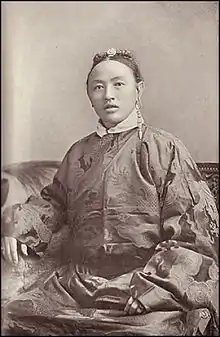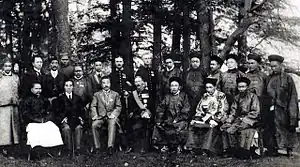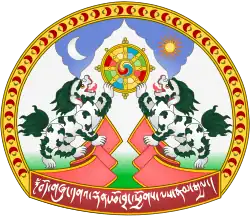
Shatra (personal name Paljor Dorje, full title Longchen Shatra Paljor Dorje (blon chen bshad sgra dpal 'byor rdo rje); བཤད་སྒྲ bshad sgra; དཔལ་འབྱོར་རྡོ་རྗེ; dpal 'byor rdo rje; c. 1860 – c. 1923/1926), was a Tibetan politician.[1][2]
Family
Shatra belonged originally to the Shangga family. He married, however, into the Shatra family, took their name and was a wealthy man. Shatra's son is the former Kalon (Religion Minister) Shasur Gyurme Sonam Topgyal, also known as Shenkhawa.
Career
In 1890 he accompanied the Chinese amban on his trip to Darjeeling and supported him during the negotiations leading to the Anglo-Chinese border treaty. Shortly afterwards he was appointed Shappe (Minister).
In 1903, he and the other three members of the inner cabinet (Kashag) were accused of treason by the Tsongdu for conspiring with the British. Conversely, however, the British accused him of conspiring with the Russians because of his cooperation with Agvan Dorzhiev.[3] The result of the accusation of the Tsongdu led to the 13th Dalai Lama deposing and banished him to his estate in Orong Kongbu (eastern Tibet). In 1915 the British reported that he had been alternately pro-Russian and pro-Chinese, but in around 1915 gained a strong anti-Chinese and pro-British attitude.
In 1907, when the Dalai Lama fled Tibet, he was recalled to Lhasa by vice-amban Zhang Yingtang and was appointed advisor to the parliament. His function was similar to a prime minister and he shared it with two other Kalon Tripa's, Changkhyim and Sholkhang. In 1915 the British reported that Shatra was the highest of the three Lönchens.
When the Dalai Lama returned to Lhasa, he won his confidence back. In 1908 he created the office of Lönchen for the three prime ministers. In 1910 he accompanied the Dalai Lama during his trip to British India.

The revolt of 1911 ushered in an era of several decades of independence, he boosted the protesters morale.[3] In 1913-14 he took part in the Simla Convention.
Reputation
He was known as a progressive politician and supporter of reform in Tibet. He had a strong character and a friendly way of dealing.
Sir Charles Bell described Shatra as follows: "He showed people skills and a political power that surprised many at the conference. His simple dignity and charming way of doing things made him beloved by all who knew him in Simla and Delhi".[3]
References
- ↑ Alex McKay (2003). The Modern Period: 1895 - 1959 ; the Encounter with Modernity. RoutledgeCurzon. pp. 269ff. ISBN 978-0-415-30844-1. Retrieved 4 December 2012.
- ↑ "Shatra - the Treasury of Lives: A Biographical Encyclopedia of Tibet, Inner Asia and the Himalayan Region".
- 1 2 3 Shakabpa, Tsepon Wangchuk Deden (4th edition 1988) Tibet: A Political History, Potala Publications, New York, ISBN 0-9611474-1-5, pag. 203, 239, 262-263
- ↑ Kobayashi, Ryosuke. "Biography of Peljor Dorje Shatra". The Treasury of Lives. The Treasury of Lives.
